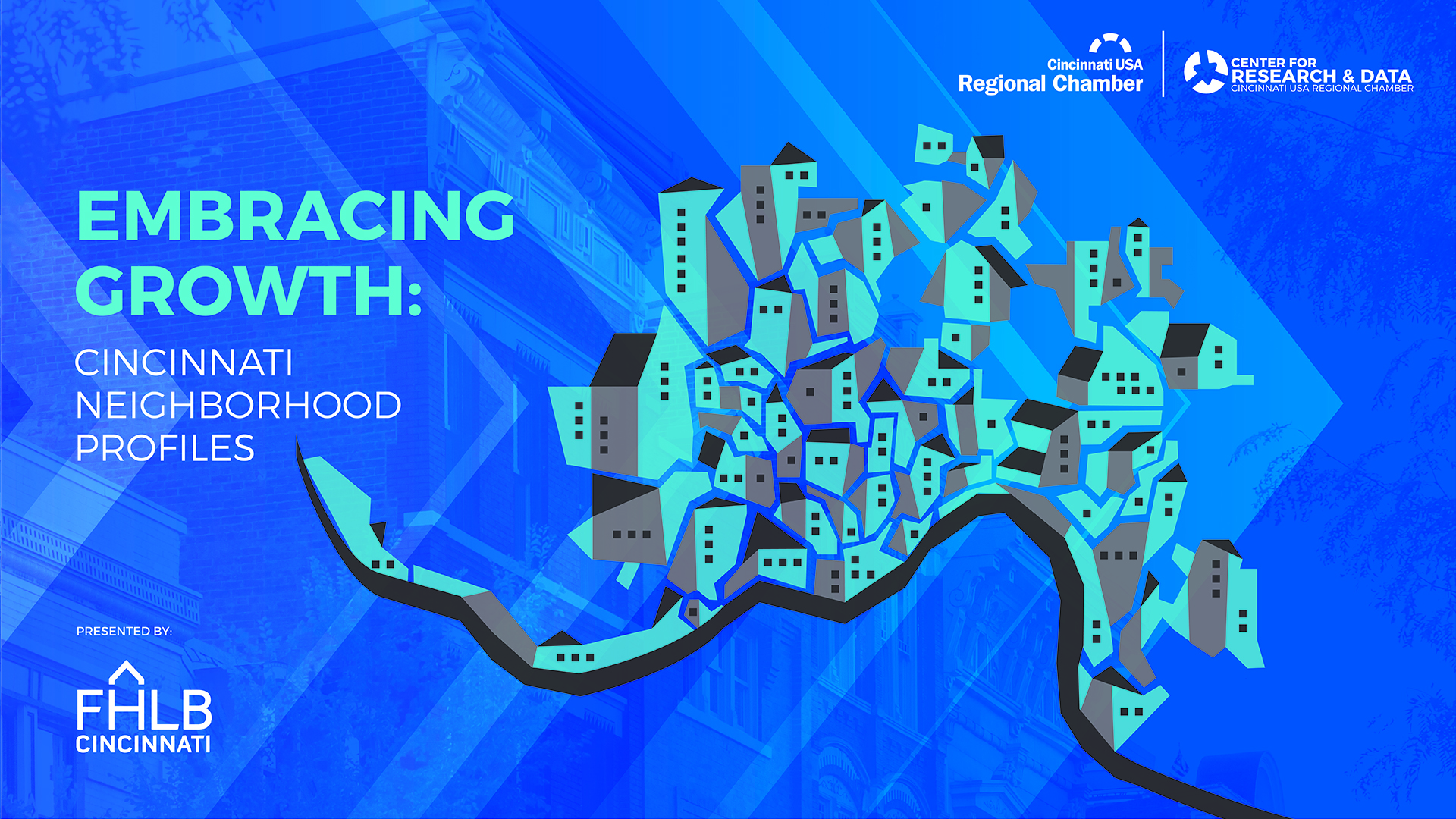Cincinnati, Ohio (March 25, 2024) – The Cincinnati Regional Chamber’s Center for Research and Data has released “Embracing Growth: Cincinnati Neighborhood Profiles.” The report presents data, analysis, and insights on population, housing, and home value growth in each of the City of Cincinnati’s 52 neighborhoods. It is the second in the “Embracing Growth” series, building on the eight housing growth principles detailed in “Embracing Growth: Principles for Regional Housing,” which was released in 2021.
“The neighborhood level analysis in ‘Embracing Growth: Cincinnati Neighborhood Profiles’ makes clear the positive impacts of building more housing in our center city neighborhoods,” said Brandon Rudd, Director of the Center for Research and Data. “The data plainly show the implications of an increasing population and a decreasing supply of housing on our City’s communities and residents.”
“Embracing Growth: Cincinnati Neighborhood Profiles” includes key takeaways and findings on the City as a whole, neighborhood growth analyses by key indicators, and individual profiles of each neighborhood with summaries of the changes seen over the last decade plus. Key takeaways and findings include:
- The City of Cincinnati lost 2,335 housing units from 2010 to 2020, a -1.5% change. Only 18 of the 52 City of Cincinnati neighborhoods experienced an increase in housing units during this period.
- In analyzing the growth in housing units and the growth in home values in Cincinnati neighborhoods since 2010, the Center for Research and Data found an inverse correlation between the number of housing units created and the growth in housing costs. In other words, the data showed that an increase in housing units resulted in slower housing cost growth.
- The ten neighborhoods that lost the most housing units in percentage terms from 2010 to 2020 saw a 346% increase in typical home value, compared to a 155% home value increase in the ten neighborhoods that saw the largest percentage increase in housing units.
- Downtown saw the highest absolute and percentage increases in housing units from 2010 to 2020, adding 1,097 which equaled a 36% increase.
- Avondale saw the highest absolute decrease in housing units from 2010 to 2020, losing 1,088, a 14.5% decrease. Avondale also lost 1,121 residents during this period, a 9% population decrease.
- While the City of Cincinnati’s population increased 4.2% from 2010 to 2020, its total population is still down significantly from its peak in the 1950s. Additionally, the Cincinnati MSA’s population growth continues to outpace that of its center city.
The population, housing units, and occupancy data included in this report are from the decennial census in 2010 and 2020, while the home value data are from the Zillow Home Value Index (ZHVI) from 2010 to 2023. The ZHVI provides a more comprehensive look at the housing market than a simple median or mean can provide. Home value data was used instead of rent data because reliable rent data is not available at such small geographic scales. More information can be found in the methodology section of the report.
About the Cincinnati USA Regional Chamber
The Cincinnati Regional Chamber is the premier business and civic organization dedicated to growing the vibrancy and economic prosperity of the Cincinnati region. To achieve its vision that Cincinnati is a growing, thriving region where everyone belongs, the Chamber seeks to grow our economy, grow our population, and grow our cultural vibrancy – with the foundation of a strong business community – to foster a welcoming environment for all. The Chamber’s membership offerings, signature leadership programs, government and regional advocacy efforts, community events such as BLINK and Oktoberfest as well as key partnerships with organizations like Cincinnati Experience, Cincinnati Compass, Cincinnati Minority Business Accelerator, and the Workforce Innovation Center lead the way in making that vision a reality. For more information, visit www.cincinnatichamber.com.
About the Center for Research and Data
The Cincinnati Chamber’s Center for Research and Data is an initiative to deliver data-driven analysis regarding vital regional indicators and outcomes. The Center helps regional leaders, community partners, and policymakers make informed decisions around priorities like talent attraction, inclusive economic growth, and communitywide goals. We provide actionable insights to support the mission and vision of the Chamber.
Media Contact:
Amy Fitzgibbons, Vice President of Marketing & Communications, Cincinnati Regional Chamber afitzgibbons@cincinnatichamber.com | 513.579.3106






